global_aging全球老龄化
- 格式:ppt
- 大小:757.00 KB
- 文档页数:8
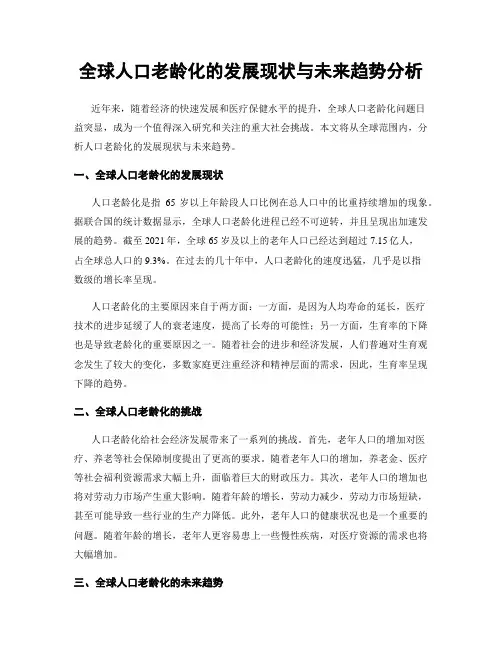
全球人口老龄化的发展现状与未来趋势分析近年来,随着经济的快速发展和医疗保健水平的提升,全球人口老龄化问题日益突显,成为一个值得深入研究和关注的重大社会挑战。
本文将从全球范围内,分析人口老龄化的发展现状与未来趋势。
一、全球人口老龄化的发展现状人口老龄化是指65岁以上年龄段人口比例在总人口中的比重持续增加的现象。
据联合国的统计数据显示,全球人口老龄化进程已经不可逆转,并且呈现出加速发展的趋势。
截至2021年,全球65岁及以上的老年人口已经达到超过7.15亿人,占全球总人口的9.3%。
在过去的几十年中,人口老龄化的速度迅猛,几乎是以指数级的增长率呈现。
人口老龄化的主要原因来自于两方面:一方面,是因为人均寿命的延长,医疗技术的进步延缓了人的衰老速度,提高了长寿的可能性;另一方面,生育率的下降也是导致老龄化的重要原因之一。
随着社会的进步和经济发展,人们普遍对生育观念发生了较大的变化,多数家庭更注重经济和精神层面的需求,因此,生育率呈现下降的趋势。
二、全球人口老龄化的挑战人口老龄化给社会经济发展带来了一系列的挑战。
首先,老年人口的增加对医疗、养老等社会保障制度提出了更高的要求。
随着老年人口的增加,养老金、医疗等社会福利资源需求大幅上升,面临着巨大的财政压力。
其次,老年人口的增加也将对劳动力市场产生重大影响。
随着年龄的增长,劳动力减少,劳动力市场短缺,甚至可能导致一些行业的生产力降低。
此外,老年人口的健康状况也是一个重要的问题。
随着年龄的增长,老年人更容易患上一些慢性疾病,对医疗资源的需求也将大幅增加。
三、全球人口老龄化的未来趋势随着社会经济的发展,全球人口老龄化的未来趋势将继续向前发展。
根据联合国的预测,到了2050年,全球65岁及以上的老年人口将增加到22亿人,占全球总人口的22%左右。
这个数字意味着,全球老年人口将超过工作年龄人口,对社会和经济的影响将愈加深远。
为了应对全球人口老龄化带来的挑战,政府和社会各界需要采取一系列的措施。
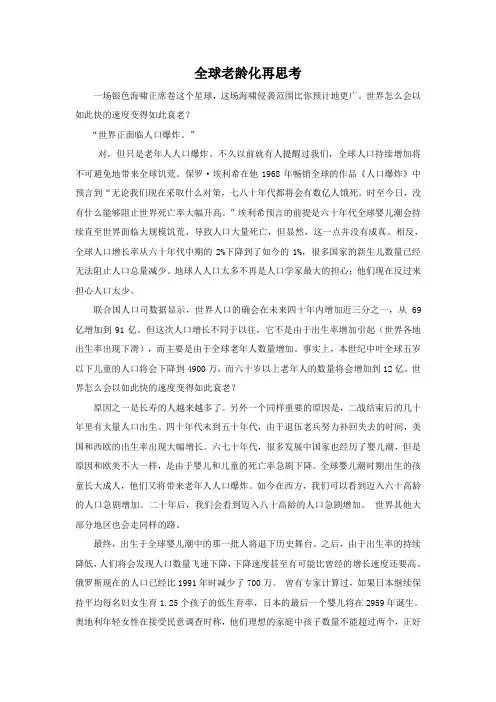
全球老龄化再思考一场银色海啸正席卷这个星球,这场海啸侵袭范围比你预计地更广。
世界怎么会以如此快的速度变得如此衰老?“世界正面临人口爆炸。
”对,但只是老年人人口爆炸。
不久以前就有人提醒过我们,全球人口持续增加将不可避免地带来全球饥荒。
保罗·埃利希在他1968年畅销全球的作品《人口爆炸》中预言到“无论我们现在采取什么对策,七八十年代都将会有数亿人饿死。
时至今日,没有什么能够阻止世界死亡率大幅升高。
”埃利希预言的前提是六十年代全球婴儿潮会持续直至世界面临大规模饥荒、导致人口大量死亡,但显然,这一点并没有成真。
相反,全球人口增长率从六十年代中期的2%下降到了如今的1%,很多国家的新生儿数量已经无法阻止人口总量减少。
地球人人口太多不再是人口学家最大的担心;他们现在反过来担心人口太少。
联合国人口司数据显示,世界人口的确会在未来四十年内增加近三分之一,从69亿增加到91亿。
但这次人口增长不同于以往,它不是由于出生率增加引起(世界各地出生率出现下滑),而主要是由于全球老年人数量增加。
事实上,本世纪中叶全球五岁以下儿童的人口将会下降到4900万,而六十岁以上老年人的数量将会增加到12亿。
世界怎么会以如此快的速度变得如此衰老?原因之一是长寿的人越来越多了。
另外一个同样重要的原因是,二战结束后的几十年里有大量人口出生。
四十年代末到五十年代,由于退伍老兵努力补回失去的时间,美国和西欧的出生率出现大幅增长。
六七十年代,很多发展中国家也经历了婴儿潮,但是原因和欧美不大一样,是由于婴儿和儿童的死亡率急剧下降。
全球婴儿潮时期出生的孩童长大成人,他们又将带来老年人人口爆炸。
如今在西方,我们可以看到迈入六十高龄的人口急剧增加。
二十年后,我们会看到迈入八十高龄的人口急剧增加。
世界其他大部分地区也会走同样的路。
最终,出生于全球婴儿潮中的那一批人将退下历史舞台。
之后,由于出生率的持续降低,人们将会发现人口数量飞速下降,下降速度甚至有可能比曾经的增长速度还要高。
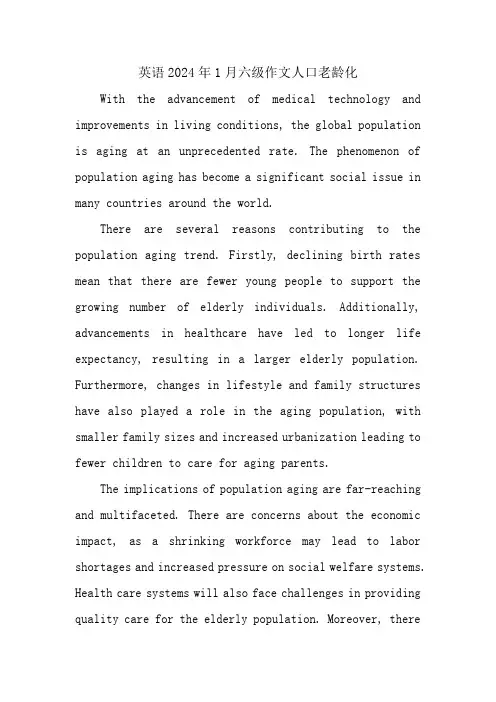
英语2024年1月六级作文人口老龄化With the advancement of medical technology and improvements in living conditions, the global population is aging at an unprecedented rate. The phenomenon of population aging has become a significant social issue in many countries around the world.There are several reasons contributing to the population aging trend. Firstly, declining birth rates mean that there are fewer young people to support the growing number of elderly individuals. Additionally, advancements in healthcare have led to longer life expectancy, resulting in a larger elderly population. Furthermore, changes in lifestyle and family structures have also played a role in the aging population, with smaller family sizes and increased urbanization leading to fewer children to care for aging parents.The implications of population aging are far-reaching and multifaceted. There are concerns about the economic impact, as a shrinking workforce may lead to labor shortages and increased pressure on social welfare systems. Health care systems will also face challenges in providing quality care for the elderly population. Moreover, theremay be social implications, such as changes in family dynamics and increased demand for elderly care services.In response to the challenges posed by population aging, governments and societies need to develop policies and programs that address the needs of the aging population. This may include measures to support elderly individuals, promote healthy aging, and create a more age-friendly environment. By addressing the challenges of population aging proactively, societies can better prepare for the demographic shift and ensure the well-being of their aging populations.中文翻译:随着医疗技术的进步和生活条件的改善,全球人口正以前所未有的速度老龄化。
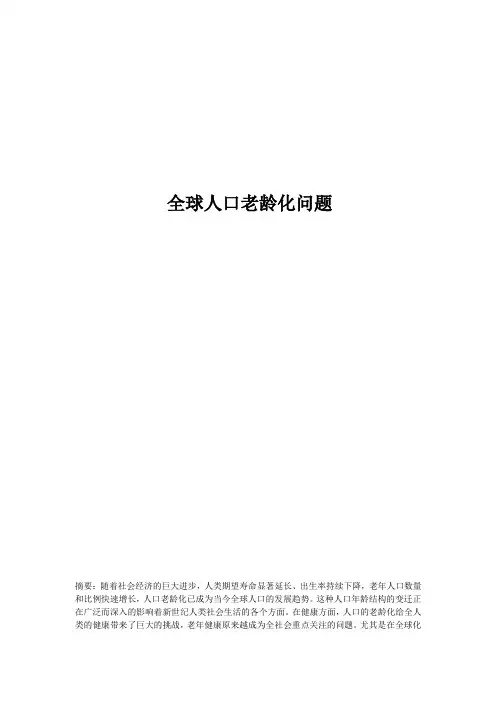
全球人口老龄化问题摘要:随着社会经济的巨大进步,人类期望寿命显著延长、出生率持续下降,老年人口数量和比例快速增长,人口老龄化已成为当今全球人口的发展趋势。
这种人口年龄结构的变迁正在广泛而深入的影响着新世纪人类社会生活的各个方面。
在健康方面,人口的老龄化给全人类的健康带来了巨大的挑战,老年健康原来越成为全社会重点关注的问题。
尤其是在全球化的浪潮之下,老龄化的治理展开,需要世界各国的共同努力。
关键词:人口老龄化、全球化、全球健康一、人口老龄化现状1、人口老龄化的含义人口老龄化是人口结构状况的一种动态变化。
人口老龄化反映一个国家(或地区)总人口中因年轻人口数量减少、老年人口数量增加而导致的老年人口的比例相应增长的动态过程。
它是指总人口年龄结构变化的过程,一般包括两个含义:一是指老年人口相对增多,在总人口中所占比例不断上升的过程;二是指社会人口结构呈现老年状态,进入老龄化社会。
老龄化社会是指老年人口占总人口达到或者超过一定比例的人口结构模型。
按照联合国的标准,一个国家或地区60岁及以上老年人口系数达到10%以上,或者65岁及以上老年人口系数为7%以上,则该国家或者地区进入老年化社会。
2、人口老龄化进程从全球人口老龄化进程来看,最初的发展比较缓慢。
欧洲工业革命前,世界所有国家65岁及以上老年人口比例未曾超过3%。
19世纪中叶,法国成为世界第一个人口老龄化国家。
40年以后,瑞典和挪威才相继进入老龄化国家的行列。
20世纪初,还只有欧洲的法国瑞典挪威英国德国爱尔兰等属于人口老龄化国家。
但至20世纪末期,全球202个国家和地区中,已有72个国家和地区达到联合国老龄化社会标准。
其中欧洲41个,拉丁美洲和加勒比地区14个,亚洲12个,北美洲2个,大洋洲2个,非洲一个;人均GDP在10000美元以上的老龄化国家或地区占36.1%,人均GDP介于3000-10000美元之间的占27.7%。
显然,在20世纪的100年中,世界老龄化已由个别成为普遍现象,由欧洲扩散到全球的各大洲,由工业化发达国家蔓延到发展中国家。


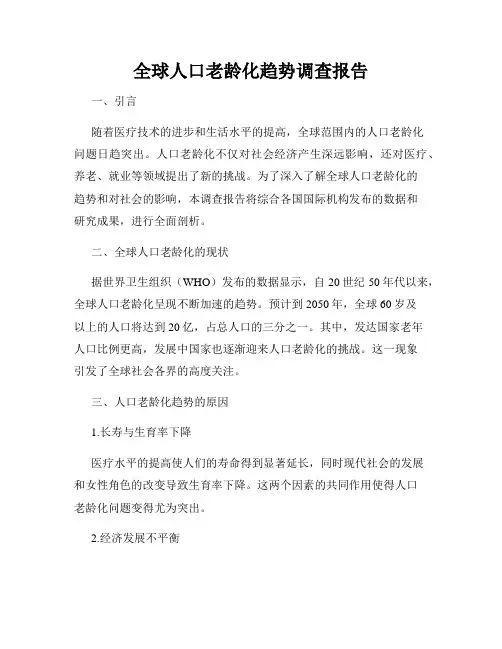
全球人口老龄化趋势调查报告一、引言随着医疗技术的进步和生活水平的提高,全球范围内的人口老龄化问题日趋突出。
人口老龄化不仅对社会经济产生深远影响,还对医疗、养老、就业等领域提出了新的挑战。
为了深入了解全球人口老龄化的趋势和对社会的影响,本调查报告将综合各国国际机构发布的数据和研究成果,进行全面剖析。
二、全球人口老龄化的现状据世界卫生组织(WHO)发布的数据显示,自20世纪50年代以来,全球人口老龄化呈现不断加速的趋势。
预计到2050年,全球60岁及以上的人口将达到20亿,占总人口的三分之一。
其中,发达国家老年人口比例更高,发展中国家也逐渐迎来人口老龄化的挑战。
这一现象引发了全球社会各界的高度关注。
三、人口老龄化趋势的原因1.长寿与生育率下降医疗水平的提高使人们的寿命得到显著延长,同时现代社会的发展和女性角色的改变导致生育率下降。
这两个因素的共同作用使得人口老龄化问题变得尤为突出。
2.经济发展不平衡经济发展水平的不平衡也是人口老龄化的重要原因之一。
发达国家由于长期的工业化进程和社会保障体系的建立,资本和技术的积累使其老龄化的程度更为明显。
而发展中国家由于经济基础薄弱和社会保障体系不完善,老年人口比例增长较为迅速。
四、人口老龄化对社会的影响1.压力增大的医疗系统老年人口的增加使得医疗资源面临更大的压力和挑战。
需要更多的医疗服务、养老护理和药物等资源,而供给方面却面临着人才短缺和资金不足的问题。
2.养老体系的亟待完善人口老龄化对养老体系提出了更高要求。
传统的家庭养老方式逐渐无法满足老年人需求,养老院、居家养老以及社会养老保险等新的养老模式亟需完善和发展。
3.劳动力供需失衡人口老龄化带来劳动力供需失衡的问题。
劳动力市场上的年轻人减少,而老年人的工作能力和就业需求又与年轻人存在一定差异,这给就业市场带来了新的挑战。
五、应对全球人口老龄化的措施1.加强健康教育通过加强老年人的健康教育,提高老年人的健康素养和自我管理能力,减轻医疗服务的压力。



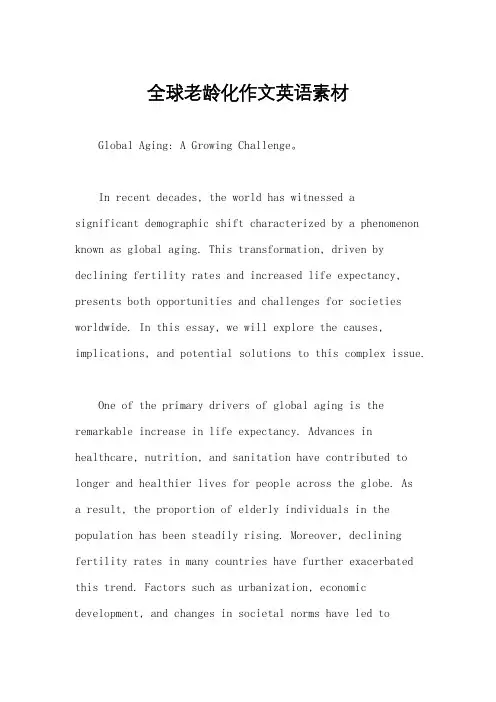
全球老龄化作文英语素材Global Aging: A Growing Challenge。
In recent decades, the world has witnessed asignificant demographic shift characterized by a phenomenon known as global aging. This transformation, driven by declining fertility rates and increased life expectancy, presents both opportunities and challenges for societies worldwide. In this essay, we will explore the causes, implications, and potential solutions to this complex issue.One of the primary drivers of global aging is the remarkable increase in life expectancy. Advances in healthcare, nutrition, and sanitation have contributed to longer and healthier lives for people across the globe. Asa result, the proportion of elderly individuals in the population has been steadily rising. Moreover, declining fertility rates in many countries have further exacerbated this trend. Factors such as urbanization, economic development, and changes in societal norms have led tosmaller family sizes and delayed childbearing, contributing to population aging.The implications of global aging are multifaceted and far-reaching. Economically, aging populations pose challenges to social security systems and pension funds. As the proportion of retirees increases relative to the working-age population, the financial sustainability of these programs becomes a pressing concern. Additionally, the healthcare sector faces increased demand for geriatric care and services, placing strain on healthcare systems and resources. Moreover, labor markets may experience shortages of skilled workers as older individuals retire and fewer young people enter the workforce.Socially, global aging can lead to changes in family structures and intergenerational relationships. With smaller family sizes and greater geographic mobility, older adults may face social isolation and loneliness. The burden of caregiving often falls on family members, particularly women, impacting their participation in the labor force and overall well-being. Furthermore, aging populations mayrequire adjustments in urban planning and infrastructure to accommodate the needs of older adults, such as accessible housing, transportation, and healthcare facilities.Addressing the challenges of global aging requires a multifaceted approach that encompasses healthcare, social welfare, labor policies, and intergenerational solidarity. Firstly, investments in healthcare and preventive medicine are crucial to promoting healthy aging and reducing the burden of age-related diseases. By prioritizingpreventative care and wellness initiatives, governments can mitigate healthcare costs and improve the quality of lifefor older adults.Secondly, reforming social security systems and pension schemes is essential to ensure their long-term sustainability. Measures such as raising the retirement age, adjusting contribution rates, and diversifying sources of funding can help alleviate financial pressures on social welfare programs. Additionally, promoting lifelong learning and skills development can facilitate the continued participation of older workers in the labor market, therebyaddressing labor shortages and promoting intergenerational solidarity.Moreover, fostering age-friendly communities and inclusive urban environments is vital for supporting the well-being of older adults. This includes investing in age-appropriate infrastructure, transportation, and housing options that enable older individuals to remain active, engaged, and independent within their communities. Furthermore, initiatives that promote social integration, volunteerism, and intergenerational activities can help combat social isolation and strengthen social cohesion across generations.In conclusion, global aging presents both challenges and opportunities for societies worldwide. By understanding the causes and implications of this demographic shift, policymakers can implement targeted interventions to address the needs of aging populations and promote a more inclusive and sustainable future for all. Through investments in healthcare, social welfare, and intergenerational solidarity, we can navigate thecomplexities of global aging and build societies that support individuals of all ages.。
全球老龄化作文英语高中Title: Global Aging: A Challenge and Opportunity。
In recent decades, the world has been witnessing a significant demographic shift characterized by a steady increase in the elderly population. This phenomenon, known as global aging, presents both challenges and opportunities for societies worldwide.First and foremost, one of the major challenges posed by global aging is the strain it puts on healthcare and social welfare systems. As people live longer, the demand for healthcare services, long-term care facilities, and pension benefits escalates. This places immense pressure on governments to ensure the sustainability of these systems amidst shrinking working-age populations and rising dependency ratios.Moreover, the economic implications of global aging cannot be overlooked. With a smaller proportion of thepopulation in the workforce, productivity growth may slow down, leading to reduced economic output and potential fiscal crises. Additionally, as older individuals typically consume more healthcare services and contribute less to the economy, there may be concerns about the long-termviability of social security programs and pension schemes.Furthermore, global aging has profound implications for family structures and intergenerational relationships. Traditionally, families have played a crucial role in providing care and support for elderly relatives. However, as societies become more urbanized and individualistic, there is a risk of weakening familial ties and a decline in the availability of informal caregiving. This could exacerbate feelings of social isolation and loneliness among the elderly, impacting their overall well-being.Despite these challenges, global aging also presents opportunities for innovation and societal advancement. One notable opportunity lies in the field of healthcare and technology. Advances in medical research and technology have the potential to improve the quality of life for olderadults, allowing them to remain independent and active for longer. From wearable health monitors to telemedicine services, technology can facilitate remote healthcare delivery and enhance access to medical resources,particularly in rural or underserved areas.Furthermore, the aging population represents a vastpool of knowledge, skills, and experience that cancontribute to economic growth and societal development. By harnessing the talents of older workers through lifelong learning initiatives and age-inclusive employment practices, societies can tap into their wealth of expertise and expertise to drive innovation and productivity.Moreover, global aging underscores the need forproactive policy responses to address the evolving needs of an aging population. This includes investing in age-friendly infrastructure, such as accessible transportation and housing, to promote independent living and social participation among older adults. Additionally, policies aimed at promoting healthy aging, such as preventative healthcare measures and wellness programs, can helpmitigate the burden of age-related diseases and disabilities.In conclusion, global aging presents multifaceted challenges that require comprehensive and coordinated responses from governments, businesses, and civil society. However, it also offers opportunities for innovation, economic growth, and social cohesion. By embracing the aging population as a valuable asset and adopting age-inclusive policies and practices, societies can navigate the demographic shift towards a more sustainable and prosperous future.。
国际组织与全球治理应对全球人口老龄化的挑战人口老龄化是指人口结构中老年人口比例不断增加的现象。
随着全球人口老龄化的加剧,国际组织和全球治理机构在应对这一挑战方面发挥着重要的作用。
本文将从国际组织和全球治理两个层面探讨人口老龄化的挑战,并分析相应的对策和解决方案。
一、国际组织的应对国际组织在应对人口老龄化挑战方面发挥着重要的协调和推动作用。
首先,国际组织可以通过制定全球人口老龄化的相关政策和标准来引导各国的行动。
其次,国际组织可以提供技术支持和经验分享,帮助各国应对人口老龄化带来的问题。
最后,国际组织可以组织全球性会议和研讨会,促进各国之间的交流与合作。
二、全球治理的应对全球治理机构可以通过建立合作机制和平台来应对人口老龄化的挑战。
首先,全球治理机构可以促进政府间的合作,加强各国之间的协调,共同应对人口老龄化带来的经济、社会和医疗等问题。
其次,全球治理机构可以推动各国加强研究和数据收集,在全球范围内进行人口老龄化的监测和评估。
最后,全球治理机构可以加强与非政府组织和私营部门的合作,形成多方参与的合力。
三、解决方案和对策为了应对全球人口老龄化的挑战,我们需要采取一系列的解决方案和对策。
首先,各国政府应制定有针对性的政策,包括提供适宜的养老福利、加强医疗保障和促进老年人就业等措施。
其次,需要加强老年人的教育和培训,提高其在社会中的地位和参与度。
同时,各国应加强老年人的社会支持网络,提供更多的社交和心理支持。
此外,可以推广健康老龄化的理念,鼓励老年人积极参与体育活动和文化娱乐等社交活动。
总结起来,人口老龄化是全球面临的重大挑战,需要国际组织和全球治理机构的共同努力来应对。
通过制定相关政策和标准、加强合作和交流,以及采取一系列的解决方案和对策,我们可以更好地应对人口老龄化带来的挑战,实现全球人口老龄化的可持续发展。
人口老龄化国际标准随着科技的发展和医疗水平的提高,全球范围内都面临着人口老龄化的问题。
人口老龄化指的是一个国家或地区的人口中老年人口比例的增加,同时,年轻人口比例的下降。
这种现象在世界各国都普遍存在,对社会、经济和医疗等多个方面产生了深远的影响。
为了更好地应对人口老龄化的挑战,国际上制定了一些标准来衡量国家或地区的老龄化程度。
一种常用的国际标准是老龄化指数(Aging Index),它表示65岁及以上人口占总人口的比例,通常以百分比表示。
老龄化指数越高,说明该国或地区的老年人口比例越高,人口老龄化程度越严重。
根据世界银行的数据,老龄化指数高于30%被视为老龄化国家或地区,而高于50%则被视为高度老龄化国家或地区。
除了老龄化指数外,国际上还通常使用老年人依赖比(Dependency Ratio)来衡量人口老龄化的程度。
老年人依赖比指的是65岁及以上人口与工作年龄人口(15-64岁人口)之比。
这一比例反映了一个国家或地区老年人口对工作年龄人口的依赖程度。
通常,老年人依赖比高于20%被认为是老龄化的国家或地区,高于30%则被视为高度老龄化的国家或地区。
此外,人口年龄结构也是衡量人口老龄化的一个重要指标。
年龄结构指人口根据不同年龄段的分布情况。
相对于年轻人口比例下降,老年人口比例的增加表明人口正朝着老龄化方向发展。
国际上通常以老年人口(65岁及以上)在总人口中所占比例来衡量年龄结构的老龄化趋势。
一般而言,老年人口比例高于7%被认为是老龄化的国家或地区,高于14%为高度老龄化的国家或地区。
人口老龄化是一个重要的社会问题,它对社会经济发展、医疗卫生等方面产生了深远的影响。
随着老年人口比重的增加,社会的养老压力逐渐增加,对养老机构、医疗服务和社会保障等方面提出了更高的要求。
此外,老年人口的增加也对劳动力市场、家庭结构和社会文化产生了影响。
因此,应对人口老龄化问题,需要制定相应的政策和措施,以应对老龄化对社会的挑战。
世界各国老龄化调查报告世界各国老龄化调查报告目前,世界各国面临一个共同的课题:人口老龄化。
所谓人口老龄化,国际上公认的定义是指社会中≥60岁人口超过总人口的10%,或≥65岁人口超过总人口的7%。
在20世纪里,人口寿命发生了巨大变化,平均预期寿命比1950年延长了20年,达到66岁,预计到2050年将再延长10年;人口结构方面的这一长足进展以及21世纪上半叶人口的迅速增长意味着60岁以上的人口从2000年的大约6亿增加到2050年的将近20亿。
2005年联合国发布的预测显示,世界60岁以上老年人口比例将由2000年的10.0%,上升到2025年的15.1%,2050年的21.7%;65岁以上老年人口比例相应由 6.9%上升到10.5%、16.1%;年龄中位数相应由26.8岁上升到32.8岁、37.8岁。
国外人口老龄化现状1.美国:目前,美国65岁及以上老年人占全国人口的12.5%左右,2050年将达到20.7%,其中,85岁及以上人口数量将达到1800多万,是1995年的将近6倍。
在预期寿命方面,根据美国人口调查局的资料,1900年出生的人口预期寿命是47岁,1950年出生的人口预期寿命为68岁,而2000年出生的则为77 岁。
目前男女65岁老人的预期寿命分别为16和19年,而在20世纪初分别为11和12年,男女65岁老人的预期寿命分别增长约40%和60%。
在医疗需求方面,美国约40%的老人需要在医院或其他护理机构度过一段时间,而约有4.5%的老人将在那里度过余生。
而且,根据目前增长速度估计,2030年美国人住护理院的人数将达到300万,约为1995年的2倍。
这些,都预示着人口老龄化给国家带来的前所未有的'压力。
2.日本:日本人口的现状可概括为“超老”。
日本是一个长寿国,2003年统计平均寿命为男78.36岁,女85.33岁,65岁以上的老年人口占19.24%,目前还在呈上升趋势。
专家预测,2050年65岁以上的老年人口将上升到33.7%。